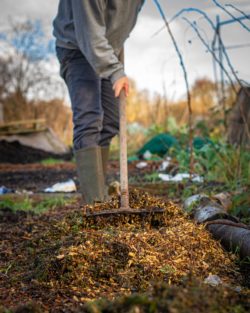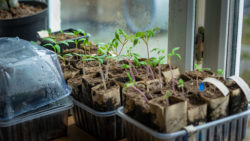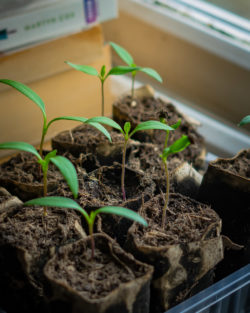Your guide to growing organically at home
If you love growing, and love what organic means for biodiversity and the sustainability of the soil and the land, it just makes sense to try and grow following organic methods at home.
But, isn’t organic growing super-complicated with all that certification and checks? For farmers and producers, it rightly is – to ensure that consumers can be certain of a product that measures up to high organic standards.
The great news is that organic growing at home doesn’t have to be complex at all – in fact, we think it is simpler than other more intrusive ways of growing. Organic uses nature as inspiration and many organic practices follow what you might instinctively do as a gardener.
Perhaps the best way to decide how you might implement organic growing methods at home is to think about the main reasons why some growers might be tempted to use chemicals, namely…
Pesticides – to kill or inhibit the little creatures and diseases that might damage your plants or crop.
Herbicides – to kill or inhibit the plants that you don’t want to grow and compete with your preferred plants
Fertilisers – common practice in farming (and in many gardens if we’re honest) is to supplement the essential nutrients that plants need with chemicals.
Why grow organically at home?
Pesticides and herbicides can damage biodiversity close to home and upset the delicate balance of nature. Chemicals, including fertilisers, can run off and cause problems for the wider environment.
Did you know? Healthy soil is one of the most important carbon stores we have at our disposal. This is achieved through the storage of carbon (from dead things) in humus (a complex and stable carbon-based derivative of organic matter) in soil. The use of chemical fertilisers means that farmers don’t need to replace organic matter in the soil and so negates this important part of the carbon cycle, resulting in lower levels of sequestered carbon in the soil.
Where to start?
The number one rule, and if you only do one thing, is keep healthy plants. Feed (organically) your plants well, water them as necessary and make sure they’re growing in the right conditions considering light, temperature and the type of soil – and your plants will be off to the best start in fighting off unwanted pests, diseases and weeds.
Let’s look at the alternatives to the big three drivers of chemical use in growing that you can implement at home.
-
Bugs and diseases
- There are loads of organic solutions for keeping the bugs off your plants – many you will know of already.
- It might take a little time, but hand picking (or squashing) bugs like aphids is a great way of reducing pest infestations. Just try to get in there early before the problem gets too big.
- Barriers, like netting over brassicas and fruit bushes, is another option to keep away unwanted pests.
- Think about growing ‘companion’ plants in your patch – these might be ‘sacrificial plants’ to distract critters from your prize crops (for example Nasturtiums can be planted to make a tasty meal for aphids and draw them away from your other plants). Similarly, options like French Marigolds (Tagetes) emit strong odours that deter pests (helping to protect the other plants in the vicinity too).
- Diseases are a little trickier. But good plant husbandry is the key to limiting disease in the garden, allotment, greenhouse or home. At the first signs of disease isolate the affected plants and keep them away from healthy examples. You may even have to sacrifice these plants to keep the rest safe. For larger plants you may see the first signs of disease on a few stems – using secateurs, cut these off promptly and dispose of them in green waste or burn them. Don’t put them on your compost or the disease might spread! Being careful when pruning and carefully discarding any diseased plant material can really limit the spread.
- Diverse planting – just as we want a biodiversity in the animal life in our gardens and allotments, a diverse plant life is important too. Monocultures can perpetuate problems with pests and diseases and a rich and diverse selection of plants, grown naturally, can tackle this.
-
Weeds
- Chemicals are generally not an option to deal with weeds – however, a natural substance like acetic acid (watered down vinegar) can be used to spray on to and kill weeds in an organic system. This won’t kill weeds that have a strong root system underground.
- The best and trusted organic method for weeding is by hand. Grab a trowel, or fancy Japanese Hori Hori knife, and carefully dig tricky weeds (like dandelions) out – root and all. For a long term satisfying, and invigorating job.
- Hoeing is a great way to prepare a large area of land such as an allotment for planting. Especially with lots of annual weeds, such as Hairy Bittercress, which have small root systems and can easily be killed by chopping the top off. Do it before your weeds get a chance to seed, and on a sunny, hot and windy day ideally – the weeds will die pretty much immediately. Unfortunately, this doesn’t work so well on perennial weeds, but it can keep them at bay.

- Mulching – think about covering areas of land that will be left bare for a time with an organic substance that stops weed growth – cardboard, impenetrable material or a good layer of bark or compost is even better. Then weeds won’t be able to quickly take hold. You can also mulch with bark around established plants in your garden.
- Even better, think about sowing a green manure – plants that can grow quickly, out-completing the weeds, and when you’re ready to plant your desired crop, or plants, hoe the green manure down and it will supplement the nutrients in your soil.
-
Nutrients
- Plants need nutrients to grow healthily and fend off disease and pests. But chemicals aren’t the best, or only option. Think about how nature replaces nutrients in the soil…living things die, fall to the floor, (or they poo) and this matter starts to break down due to the work of micro-organisms and detritivores (woodlice etc), all the good stuff in their bodies is gradually broken down and is cleverly incorporated into the soil in the form of humus. Humus is amazing stuff (even better than our home-made hummus). It is incredibly stable and forms strong bonds with the non-organic matter in soil, helping to store and gradually release nutrients, absorb and hold water and prevent soil erosion.
- So, think about how we can replicate this at home? Composting is a great way of reusing all of the waste materials from your garden and kitchen. Some key things to think about are the mix of green (wet) materials like grass versus brown (woody) materials like, erm, wood, and paper. A healthy mix might be around 40% green and 60% brown. Keep turning your compost regularly as the oxygen really helps the organisms that do the hard work. Consider not putting meat and cooked foods from the kitchen into your compost as this potentially attracts rats. We could talk for a long time about compost – but rather than do this we’ll refer you to the Royal Horticultural Society who have loads of great info on how to compost at home.
- If you can’t compost at home, or can’t produce quite enough for your needs, you can access organic fertilisers from other sources. Well-rotted farmyard manure is a perfect option, but you could consider seaweed-based feeds and even have a go at making (rather smelly!) teas from nettles or comfrey.
Organic indoors – you can apply the general principles above to growing in the house – take good care of your plants and carefully follow watering and organic feeding routines, thinking about where best to put your plants in your space and they will have the best start. Use organic feeds like seaweed-based fertilisers and for growing mediums (compost etc to grow your plants in) – look for organic options.
We believe that organic growing is one of the key ways that we can address the challenges we face in loss of biodiversity and climate change – and this can start at home. If this article has peeked your interest, we recommend doing a bit more light reading and visiting gardens that practice organic techniques. The Organic Garden at Yeo Valley is well worth a visit, and the University of Bristol Botanic Garden is always eye-opening and also uses organic techniques. We also highly recommend looking in to the ‘no dig’ technique advocated by Charles Dowding down in Somerset.
Most importantly, don’t let the odd failure deter you from following organic techniques at home. There may be the minor disappointment (slugs!) but that is what nature intended and if we want to live in a world where nature continues to be diverse and beautiful, we have to accept that the odd critter might lunch on our plants.
Remember, it doesn’t matter what space you have to hand, you can grow a range of crops to enjoy throughout the Summer and beyond! Check out our previous guide where we talk about some of our favourite crops to grow for small spaces or allotments, here.



